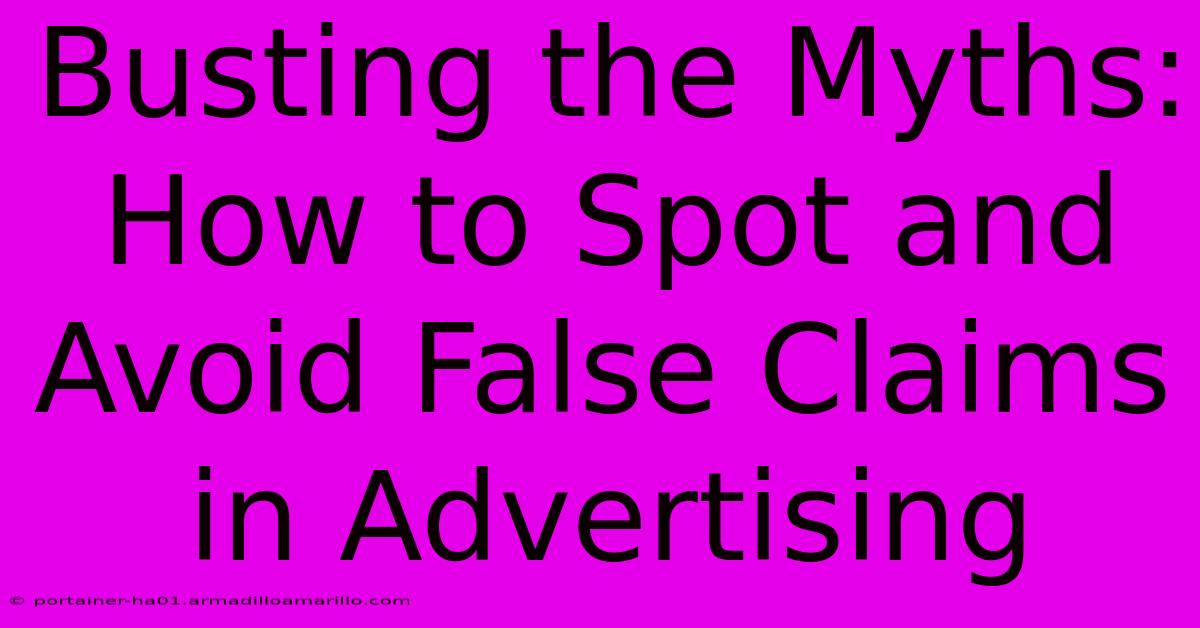Busting The Myths: How To Spot And Avoid False Claims In Advertising

Table of Contents
Busting the Myths: How to Spot and Avoid False Claims in Advertising
In today's saturated marketplace, advertising is everywhere. From catchy jingles on the radio to targeted ads on your phone, companies strive to capture our attention. But amidst the dazzling visuals and persuasive language, false advertising lurks, preying on our desires and potentially misleading us. This article will equip you with the knowledge to identify and avoid these deceptive tactics, empowering you to make informed purchasing decisions.
The Landscape of Deceptive Advertising
False advertising, also known as misleading advertising, is a serious issue. It violates consumer trust and can have significant financial and emotional consequences. Companies employ various techniques to create a false impression, including:
1. Exaggerated Claims:
- "Miracle cures" or "instant results": Beware of products promising unrealistic outcomes without scientific backing. Genuine improvements take time and effort.
- Vague language: Look out for terms like "up to," "as much as," or "helps," which lack specificity and allow for interpretation. Demand concrete evidence.
- Misleading comparisons: Products might be compared to competitors unfairly, selectively highlighting advantages while ignoring drawbacks.
2. Omitted Information:
- Hidden fees or costs: Always check the fine print for hidden charges that can dramatically inflate the final price.
- Unrealistic expectations: Advertising might create an unrealistic picture of the product or service, leading to disappointment upon purchase.
- Lack of transparency: The source of claims or the methodology used to obtain results might be undisclosed, hindering verification.
3. False Endorsements:
- Fake testimonials: Be wary of overly positive reviews without verifiable sources. Look for diverse opinions and independent reviews.
- Misrepresented affiliations: Companies might falsely suggest endorsements or partnerships with well-known individuals or organizations.
How to Identify False Advertising
While not foolproof, these strategies can greatly enhance your ability to identify deceptive advertising:
1. Verify Claims:
- Independent research: Don't rely solely on the advertisement. Search online for independent reviews, expert opinions, and consumer reports.
- Check the source: Investigate the company's reputation and look for evidence of past controversies or legal issues.
- Analyze the evidence: Ask yourself if the claims are supported by concrete evidence, such as scientific studies or verifiable data.
2. Look for Red Flags:
- "Too good to be true" offers: If something sounds too amazing to be true, it probably is.
- High-pressure sales tactics: Aggressive sales techniques that urge immediate action are often associated with deceptive advertising.
- Lack of contact information: Legitimate businesses usually provide clear contact details. If you can't find a way to reach the company, proceed with caution.
3. Report Suspicious Advertising:
- Contact the advertising agency: If you believe an advertisement is misleading, contact the agency responsible for creating it.
- File a complaint with consumer protection agencies: Many countries have consumer protection agencies that handle complaints about false advertising.
- Leave negative reviews (with evidence): Sharing your experience on platforms like Google Reviews or Yelp can alert other potential customers.
Protecting Yourself from Misleading Ads
Ultimately, consumer awareness is the strongest defense against false advertising. By being vigilant, questioning claims, and actively seeking information, you can empower yourself to make smart, informed purchasing choices. Remember, a responsible and ethical company will always prioritize transparency and honest representation of its products or services. Don't let misleading ads sway your decisions; make conscious choices backed by facts and independent verification.

Thank you for visiting our website wich cover about Busting The Myths: How To Spot And Avoid False Claims In Advertising. We hope the information provided has been useful to you. Feel free to contact us if you have any questions or need further assistance. See you next time and dont miss to bookmark.
Featured Posts
-
10 Stunning Yellow Suit Outfit Ideas To Enhance Your Seasonal Style
Feb 07, 2025
-
The Ultimate Guide To Using The Porsche Font Unlock Its Power
Feb 07, 2025
-
Unlock The Key To Eye Catching Designs Try The Futura Now Trial Now
Feb 07, 2025
-
Elevate Every Email The Transformative Power Of Transition Images For Your Signature
Feb 07, 2025
-
Budget Friendly Blooms 3 White Filler Flowers That Wont Break The Bank
Feb 07, 2025
